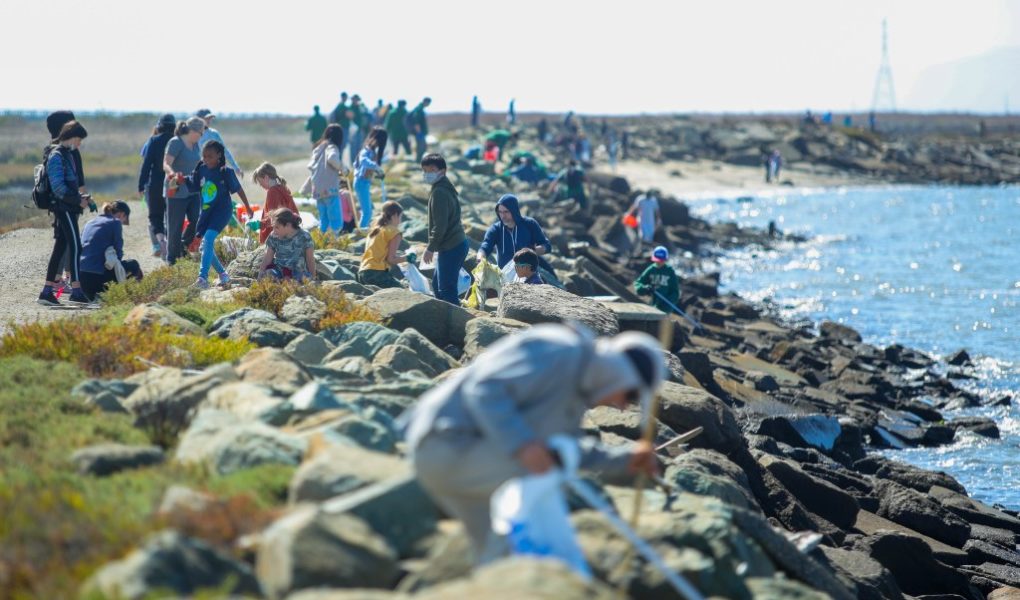
It is the largest annual volunteer event in California: Every September since 1985, tens of thousands of people have flocked to beaches, rivers and lakes across the state to pick up tons of trash, beautify the environment and help protect wildlife.
But like downtown office buildings and public transit, Coastal Cleanup Day — which takes place this Saturday from 9 am to noon at 695 locations — is struggling to rebound from the COVID pandemic.
“We’ve been seeing the volunteer numbers tick back up slowly,” said Eben Schwartz, marine debris program manager at the California Coastal Commission, which oversees the event. “We’re ramping back up to the size that we previously had. But I do think it is going to take time.”
In 2019, before COVID hit, 74,410 volunteers picked up 918,000 pounds of litter.
There was no organized Coastal Cleanup in 2020 due to the pandemic. And although the traditional cleanup day returned in 2021 and 2022, turnout last year was still only 38,467 people — about half what it was before COVID. They picked up 308,540 pounds of litter, about one-third of the pre-COVID total.
Organizers say they aren’t certain why. But they note that people got out of the habit of participating every year, either with a community group, family and neighbors, or a project organized by their employer. Some nonprofit leaders who helped run local cleanups left their organizations.
“I feel as though everyone is slowly getting back into volunteer mode,” said Jen Vanya, a spokeswoman for the East Bay Regional Park District, which is overseeing cleanups Saturday at seven locations in Alameda and Contra Costa counties. “People are kind of more home-based than they used to be.”
This year, the Coastal Commission has launched a paid social media campaign and is working overtime to try to bring one of California’s most important environmental traditions back to its full strength.
There will be events in at least 55 of California’s 58 counties, with only Sutter, Siskiyou and Trinity counties so far not participating.
Volunteers can show up at nearly all of the sites, including popular beaches on the coast, San Francisco Bay, and inland lakes and streams. In many cases, they need only bring gloves. The event is timed to take place just as summer is turning into fall. That way, trash is removed from waterways before the first rains of winter flush it into the ocean and bays.
More than 1.7 million volunteers have removed over 26 million pounds of trash from California’s outdoors since the event, now in its 39th year, began in 1985.
The debris, particularly plastic, not only makes the state’s beaches look messy, but it also can kill wildlife, like birds and sea turtles, which become entangled, or eat it.
Volunteers pick up food wrappers, bottles, cans, cigarette butts, and other debris, recording the type and number of items so the Coastal Commission can track pollution trends. They also find a laundry list of bizarre refuse every year.
“Last year somebody found a trophy. It was kind of comical. It was best couples ice skaters trophy from 2006,” Vanya said.
At Martin Luther King Jr. Regional Shoreline Park in Oakland, volunteers removed a couch from the waterfront.
Recent changes in California laws have impacted the type of litter found on beaches.
Four years ago, Gov. Gavin Newsom signed a law banning smoking on state beaches and state parks, with a fine of up to $25 per violation. Cigarette butts, nearly always the top item found each year by volume, declined to 26% of the total litter last year, down from an average of about 35% to 40% in the years before that.
Plastic bags have shown a similar drop since former Gov. Jerry Brown in 2014 signed a law banning plastic grocery bags in an attempt to reduce litter and ocean pollution. Voters upheld the law, and rejected a challenge from the plastic bag industry.
In 2009, plastic grocery bags made up 8.7% of the pieces of litter found in California during coastal cleanup days. Last year, they totaled just 1.4%.
Coastal cleanup days in other states are also finding fewer volunteers than before the COVID pandemic, Schwartz said, adding that it will take people who care about the outdoors and the state’s environment to restore the event to its past size and effectiveness.
“You may be one person out at a beach for a few hours picking up 10 pounds of trash,” he said. “But you are one of dozens at that beach, and one of tens of thousands in the state all taking part in the same activity at the same time — creating an enormous collective impact.
“This event has ripples, and they are felt throughout the year.”
To see the locations where organized cleanups are happening, go to www.coastalcleanup.org.
𝗖𝗿𝗲𝗱𝗶𝘁𝘀, 𝗖𝗼𝗽𝘆𝗿𝗶𝗴𝗵𝘁 & 𝗖𝗼𝘂𝗿𝘁𝗲𝘀𝘆: www.mercurynews.com
𝗙𝗼𝗿 𝗮𝗻𝘆 𝗰𝗼𝗺𝗽𝗹𝗮𝗶𝗻𝘁𝘀 𝗿𝗲𝗴𝗮𝗿𝗱𝗶𝗻𝗴 𝗗𝗠𝗖𝗔,
𝗣𝗹𝗲𝗮𝘀𝗲 𝘀𝗲𝗻𝗱 𝘂𝘀 𝗮𝗻 𝗲𝗺𝗮𝗶𝗹 𝗮𝘁 dmca@enspirers.com




